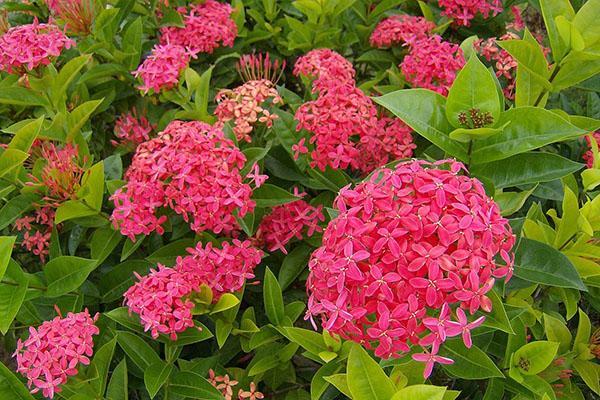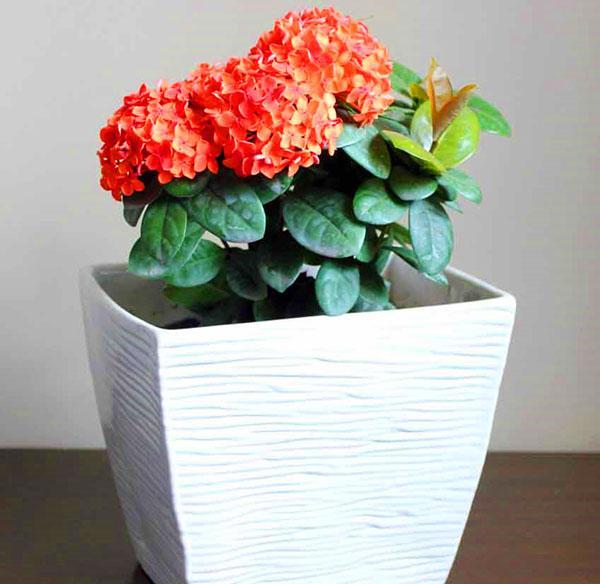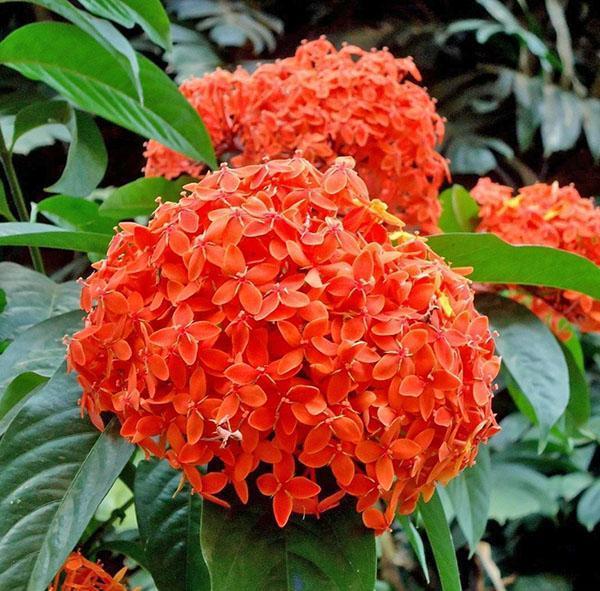Types of ixora and the rules for growing it at home
 Ixora is an exotic southern flower suitable for home cultivation. With proper care and maintenance, it feels great at home in a pot and pleases the owner with unusual bright inflorescences. This is a rather rare plant, since it does not tolerate transportation well and can lose some of its leaves along the way. However, if it can be found in a flower shop, it can bloom almost all year round. Look at photo of hosta flower!
Ixora is an exotic southern flower suitable for home cultivation. With proper care and maintenance, it feels great at home in a pot and pleases the owner with unusual bright inflorescences. This is a rather rare plant, since it does not tolerate transportation well and can lose some of its leaves along the way. However, if it can be found in a flower shop, it can bloom almost all year round. Look at photo of hosta flower!
Description of the plant and its varieties

 Flowers can be red, white, yellow, and salmon caviar. At home, Ixora bright red and Ixora Javanese are grown. They are almost identical in appearance and care requirements. You can distinguish between these two incredible species only by the shape of the sepals and the color of the inflorescences. The Javanese Ixora has amazing bright red flowers, the tips of the petals of which are pointed.
Flowers can be red, white, yellow, and salmon caviar. At home, Ixora bright red and Ixora Javanese are grown. They are almost identical in appearance and care requirements. You can distinguish between these two incredible species only by the shape of the sepals and the color of the inflorescences. The Javanese Ixora has amazing bright red flowers, the tips of the petals of which are pointed.
These plants bloom all year round, but they are especially active during the rainy season. At home, you can create suitable climatic conditions for them to bloom.
Planting and care rules
 Photos of ixora flowers look bright, and live this plant will decorate any interior. It is important to remember that the flower naturally grows in the tropics, therefore it is sensitive to temperature and watering. This is not a plant that feels good with irregular care, with a lack of moisture and in the cold, it can die.
Photos of ixora flowers look bright, and live this plant will decorate any interior. It is important to remember that the flower naturally grows in the tropics, therefore it is sensitive to temperature and watering. This is not a plant that feels good with irregular care, with a lack of moisture and in the cold, it can die.
In the summer, the plant can be moved to fresh air, but it does not tolerate frost
Temperature control and lighting
 When choosing a suitable place for Ixora, it must be borne in mind that it does not tolerate temperature changes, but prefers well-lit places. It can be grown indoors or under lamps.
When choosing a suitable place for Ixora, it must be borne in mind that it does not tolerate temperature changes, but prefers well-lit places. It can be grown indoors or under lamps.
Basic requirements for plant maintenance:
- daytime temperature - at least 20 degrees, heat up to 30 degrees and more, it tolerates well;
- a lot of sunlight, otherwise the leaves and flowers will be dull;
- the air temperature in winter can drop to 15 degrees, but the flower should get used to this gradually.
In the summer, the pots can be taken out onto the balcony or veranda, but only on condition that there is no cold snap at night. You need to harden the flower gradually - in the summer, put it on the windowsill near the window, which will constantly open. If it is grown under lamps, the distance from the light source to the top should be at least 15 cm.
The flower needs good lighting, some people prefer to grow it under a lamp
Soil, top dressing and watering regime
 Planting and caring for an ishora flower is not difficult if the room is warm and light enough. A large pot is suitable for this plant, which is rounded downwards, and at its bottom there must be holes to remove excess moisture. A special drain must be placed under the ground - you can buy it at any store or use foam for this purpose.
Planting and caring for an ishora flower is not difficult if the room is warm and light enough. A large pot is suitable for this plant, which is rounded downwards, and at its bottom there must be holes to remove excess moisture. A special drain must be placed under the ground - you can buy it at any store or use foam for this purpose.
The composition of the soil is another requirement, without which the flower cannot grow tall and healthy. Its environment must be slightly acidic, and the soil must be loosened regularly.
The substrate for flower growth can be prepared at home from the following components:
- turf or garden land, which can be purchased at the store;
- sand;
- as a top dressing - humus, peat or compost.
The plant is watered regularly as soon as the topsoil begins to dry out. Water at room temperature, standing for several days, is suitable. It is also necessary to regulate the air humidity by spraying water from a spray bottle. It is also useful to purchase top dressing for ornamental plants and add them to the soil once every 2 weeks in the summer and once a month in the winter.
The main sign that the plant is not getting enough moisture is the dropping of the lower leaves. They are not restored, so it is better to monitor the health of the flower constantly.
Reproduction of ixora
 The plant can be propagated all year round by cuttings. To do this, after flowering, you need to cut off several shoots and put them in a container with water to root. The first roots of Ixora are released in 1-2 weeks, and after 3 weeks they become strong enough to transplant the flower into the ground. Organic fertilizers are immediately applied to the pot so that the plant quickly takes root. To accelerate the growth of roots on the shoots, you can use special store products (Kornevin).
The plant can be propagated all year round by cuttings. To do this, after flowering, you need to cut off several shoots and put them in a container with water to root. The first roots of Ixora are released in 1-2 weeks, and after 3 weeks they become strong enough to transplant the flower into the ground. Organic fertilizers are immediately applied to the pot so that the plant quickly takes root. To accelerate the growth of roots on the shoots, you can use special store products (Kornevin).
Some varieties of this plant can be grown to create miniature plants - bonsai
Ixora looks great in pots on a windowsill. Due to the fact that she prefers well-lit areas, it is not recommended to place her next to tall plants. The neighborhood for this flower is important, since it will be necessary to maintain high humidity around it. With proper care and regular watering, large inflorescences with small multi-colored flowers appear. They can be of different shades, but most varieties bloom in red or yellow flowers. There are few varieties of this plant on sale; there are many more of them in nature. This is due to the difficulties of transportation and the ability of varieties to adapt to the climate in foreign countries.